|
|
|
Sort Order |
|
|
|
Items / Page
|
|
|
|
|
|
|
| Srl | Item |
| 1 |
ID:
154196
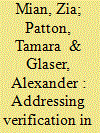

|
|
|
|
|
| Summary/Abstract |
The UN General Assembly last December called for negotiations this year to produce a "legally binding instrument to prohibit nuclear weapons, leading to their total elimination." The nuclear ban treaty talks will have to engage the issue of confirming compliance by the parties with the specific prohibitions established by such a treaty and, in addition, can establish guiding principles for the process of eliminating nuclear weapons and maintaining the resulting nuclear-weapon-free world.
|
|
|
|
|
|
|
|
|
|
|
|
|
|
|
|
| 2 |
ID:
132781
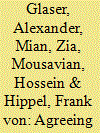

|
|
|
|
|
| Publication |
2014.
|
| Summary/Abstract |
Iran is negotiating with a group of six states over the future of its nuclear program. In November 2013, Iran and the P5+1 (China, France, Germany, Russia, the United Kingdom, and the United States) agreed to a Joint Plan of Action that seeks to reach a "comprehensive solution" by July 20, 2014.
The goal is an agreement on a set of measures that can provide reasonable assurance that Iran's nuclear program will be used only for peaceful purposes and enable the lifting of international sanctions imposed on Iran over the past decade because of proliferation concerns.
A key challenge is to reach agreement on limiting Iran's uranium-enrichment program, which is based on gas centrifuges, in a way that would enable Iran to meet what it sees as its future needs for low-enriched uranium (LEU) fuel for nuclear research and power reactors while forestalling the possibility that this program could be adapted to quickly produce highly enriched uranium at levels and in amounts suitable for use in nuclear weapons
|
|
|
|
|
|
|
|
|
|
|
|
|
|
|
|
| 3 |
ID:
091922


|
|
|
| 4 |
ID:
084021
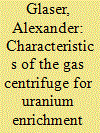

|
|
|
|
|
| Publication |
2008.
|
| Summary/Abstract |
This article presents an analytical model, originally developed in the 1980s, for the gas centrifuge and uses this methodology to determine the main design and operational characteristics of several hypothetical centrifuge designs. A series of simulations for a typical first-generation machine is used to assess the relevance of important breakout scenarios, including batch recycling and cascade interconnection, using either natural uranium or preenriched material as feedstock.
|
|
|
|
|
|
|
|
|
|
|
|
|
|
|
|
| 5 |
ID:
127633
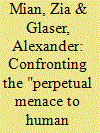

|
|
|
|
|
| Publication |
2014.
|
| Summary/Abstract |
Nuclear weapon states historically have attached great secrecy to their nuclear weapon and fissile material production programs and stockpiles, despite warnings that this would fuel fears, handicap informed debate and decision making, and drive arms races. As evidenced by the "Action Plan on Nuclear Disarmament" agreed upon at the 2010 Treaty on the Non-Proliferation of Nuclear Weapons (NPT) Review Conference, however, the international community now sees greater transparency about nuclear weapon and fissile material stocks as necessary for enabling and monitoring progress toward nuclear disarmament. To support this effort, the International Panel on Fissile Materials has proposed a step-by-step program for weapon states to declare their inventories, production histories, and disposition of nuclear warheads and fissile materials, and to set up joint projects to develop methods for verifying these declarations. This openness initiative is described here, and could be adopted at the 2015 NPT Review Conference, laying a basis for negotiating verifiable deep reductions in nuclear arsenals and their eventual elimination.
|
|
|
|
|
|
|
|
|
|
|
|
|
|
|
|
| 6 |
ID:
142270


|
|
|
|
|
| Summary/Abstract |
This article examines possible modifications of Iran’s IR-40 (Arak) heavy-water reactor that would limit its plutonium production without compromising its usefulness for civilian purposes. The proposed modifications only involve the fuel composition, avoid changes to the fuel and core geometry, and therefore have the advantage of minimizing the overall complexity and cost of conversion as well as shortening the time period required to implement these modifications. The suggested changes would significantly reduce the reactor’s production of plutonium from 7–9 kilograms to less than 1 kilogram per year. The article also examines key safety parameters, medical isotope production rates, and uranium resource requirements for all modifications considered. The analysis is relevant beyond the case of Iran’s Arak reactor and may provide some future guidance for converting other heavy-water reactors that continue to operate today.
|
|
|
|
|
|
|
|
|
|
|
|
|
|
|
|
| 7 |
ID:
169456


|
|
|
|
|
| Summary/Abstract |
Researchers have recently proposed a new approach to nuclear-arms-control verification, dubbed “deferred verification.” The concept forgoes inspections at sensitive nuclear sites and of nuclear weapons or components in classified form. To implement this concept, a state first divides its nuclear program into a closed segment and an open segment. The total fissile-material inventory in the closed segment, which includes the weapon complex, is known and declared with very high accuracy. Essentially no inspections take place in the closed segment. In contrast, inspectors have access to the open segment, which includes in particular the civilian nuclear sector. The fissile-material inventory in the open segment is known with less accuracy, but uncertainties can be reduced over time using nuclear-archaeology methods. Deferred verification relies primarily on established safeguards techniques and avoids many unresolved verification challenges, such as the need for information barriers for warhead confirmation measurements. At the same time, deferred verification faces some unique challenges. Here, we explore some of these challenges and offer possible solutions; to do so, we examine possible noncompliance strategies in which a state would seek to withhold a higher-than-declared inventory.
|
|
|
|
|
|
|
|
|
|
|
|
|
|
|
|
| 8 |
ID:
111133
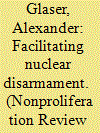

|
|
|
|
|
| Publication |
2012.
|
| Summary/Abstract |
Unprecedented interest in seeking progress toward nuclear disarmament exists today; even some nuclear weapon states are looking for new ways to strengthen this process. National declarations of fissile material holdings-highly enriched uranium and plutonium-could play an important role in supporting this effort, facilitating not only transparency but also the irreversibility of the process. This article discusses what kind of content such declarations could have in order to be meaningful and effective, the sequence of data on fissile material holdings that states might release, and some of the challenges to be expected in reconstructing historic fissile material production; it also summarizes current attitudes of weapon states toward making such declarations. Initial declarations can be valuable as confidence-building measures, but better and more background data are necessary if declarations are to serve as the groundwork for deeper cuts in the nuclear arsenals. A robust verification approach would ultimately require inspectors to have access to fissile material production and storage sites. The methods and tools of nuclear forensic analysis-in this context also dubbed nuclear archaeology-would be a key element of this process. This article discusses the capabilities and limitations of potential approaches to verifying declarations of historic production of plutonium and highly enriched uranium; it also identifies and discusses opportunities for further research and development.
|
|
|
|
|
|
|
|
|
|
|
|
|
|
|
|
| 9 |
ID:
085059
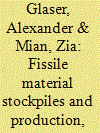

|
|
|
|
|
| Publication |
2008.
|
| Summary/Abstract |
This article presents estimates of global and national stockpiles of highly enriched uranium and separated plutonium based on the 2008 Global Fissile Material Report by the International Panel on Fissile Materials.1 The global stockpile of highly enriched uranium (HEU) is estimated to be 1670 ± 300 tons. It is declining as Russia and the United States blend down about 40 tons per year of HEU for use in light-water power-reactor fuel. This rate of blend-down is far higher than the estimated rate of production of HEU, currently believed to be limited to production by Pakistan for weapons and by India for naval fuel. The global stockpile of separated plutonium, all of which can be used for weapons, is about 500 tons. About half of this stockpile is civilian and is currently growing at less than 5 tons a year. This rate will increase significantly once Japan's Rokkasho reprocessing plant begins commercial operation. Only India and Pakistan and perhaps Israel are believed to be producing plutonium for weapons, at a combined rate of less than 60 kg per year. The United States and Russia have declared as excess to weapons requirements or for all military purposes a significant fraction of their stocks of both highly enriched uranium and plutonium produced for weapons. The United States and Russia continue to blend down the 210 and 500 tons, respectively, of HEU that they have declared excess to produce low-enriched uranium to fuel light-water reactors. The United States and Russia have yet to put in place the infrastructure to eliminate the 34 tons of excess weapons plutonium each committed to dispose under the 2000 U.S.-Russian Plutonium Management and Disposition Agreement. The past two years have also seen plans for new civilian enrichment plants and progress on new reprocessing plants. During this time, some former production facilities have been shut down, others dismantled, and in some cases key components have been demolished.
|
|
|
|
|
|
|
|
|
|
|
|
|
|
|
|
| 10 |
ID:
067765
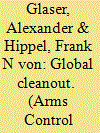

|
|
|
| 11 |
ID:
115973


|
|
|
|
|
| Publication |
2012.
|
| Summary/Abstract |
Converting research reactors from highly enriched uranium (HEU) fuel to more proliferation-resistant low-enriched fuel is critical for achieving the objective of ending the use of directly weapon-usable materials in the civilian nuclear fuel cycle. The most challenging type of reactors to convert are high-flux research reactors, which, along with upcoming strong spallation sources, are the most important neutron sources for sophisticated neutron scattering experiments. Advanced Monte-Carlo computer codes are now available that make it possible to track neutrons from the neutron source, through neutron guides, to the detector of a neutronic experimental setup, including realistic samples. These "virtual experiments" allow optimizing the performance of complete beamlines, where in many cases a large unused potential exists for increasing the neutron flux at the sample or detector position. The Monte-Carlo codes VITESS and McStas are used to compare results for typical neutron scattering setups using typical versus state-of-the-art technologies. The analysis shows that performance gains due to instrument upgrades or neutron guide renewals can dwarf potential neutron flux losses due to conversion to low-enriched fuel. Combined convert-and-upgrade strategies therefore offer unique opportunities for reactor operators and neutron scientists to significantly improve the overall performance of research facilities, and turn them into centers of excellence, while supporting the objective of phasing out the use of highly enriched uranium in the civilian nuclear fuel cycle as soon as possible.
|
|
|
|
|
|
|
|
|
|
|
|
|
|
|
|
| 12 |
ID:
135309


|
|
|
|
|
| Summary/Abstract |
Gaseous diffusion was historically the most widely used technology for military production of highly enriched uranium. Since June 2013, all gaseous diffusion enrichment plants worldwide are permanently shut down. The experience with decommissioning some of these plants has shown that they contain large amounts of uranium particles deposited in the cascade equipment. This article evaluates the potential of using uranium particle deposition to understand and reconstruct the operating histories of gaseous diffusion enrichment plants. First, a squared-off cascade enrichment model is derived to estimate the enrichment capacity of a reference plant. Then, using a cross-flow filtration model, the mass of solid uranium particles deposited over time in the tubular separation membranes of the stage diffusers is calculated. Finally, potential techniques to characterize these uranium deposits and help reconstruct the operating history of the plant are assessed.
|
|
|
|
|
|
|
|
|
|
|
|
|
|
|
|
| 13 |
ID:
108154


|
|
|
|
|
| Publication |
2011.
|
| Summary/Abstract |
There is growing interest in a set of methods and tools that can be used to characterize past fissile material production activities, using measurements and sampling at production and storage sites. This field has been dubbed "nuclear archaeology." The best-established example of nuclear archaeology relies on measurements of the isotope ratios of selected elements in the graphite of graphite-moderated plutonium production reactors. This Graphite Isotope-Ratio Method (GIRM) determines the cumulative neutron fluence through the graphite and thereby estimates the cumulative plutonium production in the reactor. The great limitation of this particular method is that it can only be applied to graphite-moderated reactors, which represent only one class of reactors that have been used for unsafeguarded plutonium production. In this article, we propose to extend this method to non-graphite moderated reactors by analyzing the evolution of relevant isotope ratios in the support structures and other core components of heavy-water moderated reactors. We present results of neutronics calculations for a generic heavy-moderated reactor evaluating the robustness of the method and explore the role of nuclear archaeology for applications in arms-control treaty verification.
|
|
|
|
|
|
|
|
|
|
|
|
|
|
|
|
| 14 |
ID:
142264


|
|
|
|
|
| Summary/Abstract |
Verification of current nuclear arms control treaties between United States and Russia relies primarily on the verification of delivery vehicles. Warheads are counted indirectly via the delivery vehicles that they are associated with. As states move to lower numbers of nuclear weapons in their arsenals, verification will likely pose complex challenges. Most importantly, future nuclear disarmament treaties may place limits on the total number of nuclear weapons in the arsenals. Their verification would require inspections of individual nuclear warheads without revealing secret information. Confirming the authenticity of nuclear warheads and perhaps also of warhead components is at the center of the verification challenge for future reductions in the nuclear arsenals. This paper provides an overview of the development of verification systems, and highlights the challenges and the opportunities for future research in this area.
|
|
|
|
|
|
|
|
|
|
|
|
|
|
|
|
| 15 |
ID:
077013


|
|
|
|
|
| Publication |
2006.
|
| Summary/Abstract |
This article reviews the rationale of selecting an enrichment of just less than 20% (low-enriched uranium) as the preferred enrichment level for research reactor fuel in order to minimize overall proliferation risks. The net strategic value of the nuclear material associated with reactor operation is evaluated for a variety of enrichment levels, ranging from slightly enriched to weapon-grade fuel. To quantify the proliferation potential, both the demand of fresh uranium fuel as well as the plutonium buildup in the irradiated fuel are estimated via cell burnup calculations. The analysis confirms the usefulness of the current enrichment limit and challenges a recent trend to reconsider fuel enrichment levels between 20% and 50% for new research reactor projects
|
|
|
|
|
|
|
|
|
|
|
|
|
|
|
|
| 16 |
ID:
183213


|
|
|
|
|
| Summary/Abstract |
Since the early 1960s, Israel has used the Dimona reactor in the Negev Desert for unsafeguarded plutonium production. Estimates of cumulative plutonium production have been very uncertain, however, because the power level of the reactor is unknown, and there is a lack of detail about the reactor design. This analysis presents new estimates of historic plutonium production in Israel based on neutronics calculations for the Dimona reactor. As of December 2020, we estimate that the cumulative production of plutonium is 830 ± 100 kg. Israel continues to operate the Dimona reactor today, possibly to offset the decay of its stock of tritium. For these reasons, the production of tritium and the possible production of enriched uranium are also briefly discussed. Calculations suggest that the reactor could make on the order of 50–60 grams of tritium and support an arsenal of about one hundred advanced nuclear weapons. The paper also includes a critical review of the 1986 testimony by the Dimona technician and whistleblower Mordechai Vanunu, which provided much of the basis for public discussion of the reactor’s power and operation.
|
|
|
|
|
|
|
|
|
|
|
|
|
|
|
|
| 17 |
ID:
080443


|
|
|
|
|
| Publication |
2007.
|
| Summary/Abstract |
India is building a 500 MWe Prototype Fast Breeder Reactor, which is scheduled to be operational by 2010. India has refused to accept international safeguards on this facility, raising concerns that the plutonium produced in its uranium blankets might be used to make nuclear weapons. Based on neutronics calculations for a detailed three-dimensional model of the reactor, we estimate that up to 140 kg of weapon-grade plutonium could be produced with this facility each year. This article shows how India's large stockpile of separated reactor-grade plutonium from its unsafeguarded spent heavy-water reactor fuel could serve as makeup fuel to allow such diversion of the weapon-grade plutonium from the blankets of the fast breeder reactor. We describe and assess the most plausible refueling strategies for producing weapon-grade plutonium in this way.
|
|
|
|
|
|
|
|
|
|
|
|
|
|
|
|
| 18 |
ID:
130326
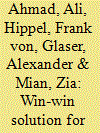

|
|
|
|
|
| Publication |
2014.
|
| Summary/Abstract |
In November 2013, Iran and the P5+1 group of countries (China, France, Germany, Russia, the United Kingdom, and the United States) agreed on a six-month Joint Plan of Action to enable negotiations on a final settlement to contain the proliferation risks from Iran's nuclear program. This interim agreement freezes Iran's enrichment capacity, thereby preventing a further shortening of the time Iran would require to produce weapons quantities of highly enriched uranium (HEU) if it wished.1 This enrichment capacity has expanded greatly over the years since it first came to international attention in 2002. Iran and the P5+1 also have agreed on the need to constrain Iran's option to produce plutonium for weapons using the reactor that is under construction near the city of Arak and that will be under International Atomic Energy Agency (IAEA) safeguards. Under the Joint Plan of Action, Iran has agreed to freeze the Arak reactor project for six months.2 It also has committed not to separate plutonium from spent nuclear fuel or construct a facility capable of doing so. These are important interim commitments. According to Ali Akbar Salehi, the head of the Atomic Energy Organization of Iran, the Arak reactor is intended for radioisotope production and testing of nuclear fuel and materials. In response to the P5+1 proposal that Iran scrap the Arak reactor project, Salehi stated that "we see no point stopping the work on this reactor." He has acknowledged, however, the international community's concerns about the Arak reactor and offered the possibility of design changes "in order to produce less plutonium in this reactor and in this way allay the worries and mitigate the concerns.
|
|
|
|
|
|
|
|
|
|
|
|
|
|
|
|
|
|
|
|
|